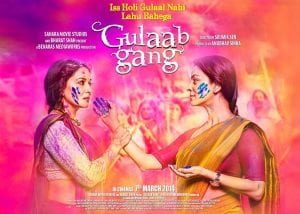Lights, camera, action! To the majority of Americans, such words bring to mind the image of bright white, large letters spelling out HOLLYWOOD and a sweeping view of backlot movie sets. There is, however, another view of these words—one also characterized by glamorous movie stars and flashing lights. Bollywood is the coined term for the Indian filmmaking industry, one typified in the musical and dance numbers placed into films, no matter how ham-stringed the reasoning. Gulaab Gang, a 2014 film detailing the struggle of one woman as she struggles to uplift her community, is one such example.
Bollywood film is oft portrayed in Western cinema as filled with whimsy, a place where fantastical, colorful visages of gods and goddesses are accompanied by equally intricate dances and songs. In these areas, Gulaab Gang matched expertly with expectation, as the film is rife with song and dance, instances where the gang breaks out of the film’s narrative with belted notes and synchronous moves. Unexpected, however, were the action scenes placed into the film, choreographed sequences that both break and fit into the mold of stereotype. While the consequences of a severed hand and sexual assault of a minor break the somewhat comical tone attributed to many Bollywood films, the action is also fantastical, in that a single swipe of the blade, after launching off a car, is able to incapacitate four men.
Most interestingly, however, are the contexts surrounding the film. As a Western viewer with no background knowledge upon which to contextualize the film, it was interesting to find that the circumstances surrounding the process are much the same as with Western film studios. Well-known “best-loved 1980s divas,” Madhuri Dixit and Juhi Chawla, were cast in the main roles of the film, akin to how in Hollywood the same known actors and actresses are cast again and again in film (Tsering). Controversy and scandal do not escape Bollywood film either, as Sampat Pal Devi, the woman known for originating the real Gulabi Gang, “sued to prevent the … release” of the film, stating she had not given permission for a likeness of her story to be portrayed (Tsering). Just as biopics in Western film often proceed without regard for the truth of the story, so too do films in other film industries. There are seemingly universal characteristics to the industry, indicating similarities likely abound in other aspects of social life as well between the different regions of the world.
“best-loved 1980s divas,” Madhuri Dixit and Juhi Chawla, were cast in the main roles of the film, akin to how in Hollywood the same known actors and actresses are cast again and again in film (Tsering). Controversy and scandal do not escape Bollywood film either, as Sampat Pal Devi, the woman known for originating the real Gulabi Gang, “sued to prevent the … release” of the film, stating she had not given permission for a likeness of her story to be portrayed (Tsering). Just as biopics in Western film often proceed without regard for the truth of the story, so too do films in other film industries. There are seemingly universal characteristics to the industry, indicating similarities likely abound in other aspects of social life as well between the different regions of the world.
Ultimately, the film represents both a testing and adherence to the stereotype of Bollywood film, with its bright coloring and musical overtures, viewed in the hot pink saris worn by the Gulaab Gang and the Holi festival’s colored powder intensifying the climax of the film, intermingling with a serious narrative where legs are chopped off in retaliation and a man is brought low enough to crawl on his hands and knees between a woman’s legs. With background scandals and famed actresses chewing up scenery, Bollywood and Hollywood might not be so different.
Tsering, Lisa. Rev. of Gulaab Gang, dir. Soumik Sen. The Hollywood Reporter 7 Mar. 2014. Web. 5 Dec. 2016.
Bollywood and Hollywood: The Same Exact Story?
December 5, 2016 | 0 comments

